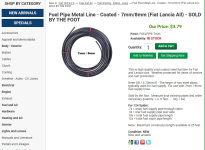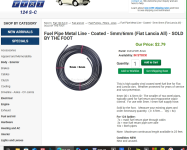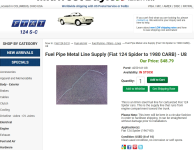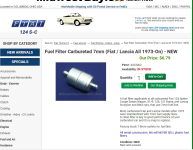@Slotman
Some fuel hard lines and a
metal fuel filter that you've probably already seen @ Midwest-Bayless:-




As regards the possible difficulty of installing hard fuel lines, I prefer to use Kunifer (aka Cunifer) Copper/Nickel tubing as it's corrosion-proof, doesn't have to be frequently supported/clipped as needed with copper tube, and most importantly, is much easier to form bends in (by hand, if needs be) in situ. There are inexpensive pipe/tube bending pliers available to deal with any required tight bends or you can use e.g. a suitably sized socket to use as a former to avoid the tube collapsing.
For Euro models, Fiat used 8mm tube for the fuel feed from the tank to the pump and carb and 6mm tube for the return line form carb to tank but I'm not sure about U.S. spec models, especially on cars fitted with emissions equipment, so this is just a suggestion.
Incidentally, on the 124 Sedan (Saloon) and 124 Sport Coupe, (which had much the same ride height as the Spider), Fiat ran hard fuel lines, both feed and return, underneath the floor-pan, the metal pipes were routed from the mechanical fuel pump and the carb return to the firewall and then passed under the transmission tunnel (clipped at intervals) to one side of the trans. then above the driveshaft and at the rear, they passed through grommeted holes into the trunk where they were attached to the fuel tank. Later models that had an electric fuel pump (located in the trunk), had both feed and return metal pipes run from the carb to the trunk.
Fiat used a type of 'nylon?' fuel pipe, black in color, inside the passenger cabin on later models than the 124, - I wonder if this type of 'plastic' pipe is available or if similar from another car manufacturer could be used instead of metal pipe?
I don't like fitting a fuel filter in a suction line e.g. from tank to pump, ideally the filter should be under pressure so should be fitted after the mechanical pump at the engine or after an electrical pump if it's mounted in the trunk.
Be careful with your choice of metal tube size if changing from the original sizes, doing so will cause issues in then connecting them to the various pipe stubs on the fuel pump, carb. and at the tank.
Be careful about opting to use inch sizes to replace a metric sizes- while 8mm is essentially 5/16 inch (5/16" is actually 7.95mm if you want to be fussy), 6mm is not the same as 1/4" (1/4" = 6.35mm).
There is not a lot of 'give' in reinforced 'rubber' type fuel hoses, so you can't really 'force' them over a swaged end brass stub, nor do you want a loose fit e.g. using 1/4" (=6.35mm) hose on 6mm pipe, you should not rely on a hose clip to squeeze the 'rubber' hose down to form a seal to the metal pipe.
A little thought can save a lot of headaches later on e.g. after you've bent & installed the new metal pipe and then attempt to fit new 'rubber' hose and connect everything up.
The reason I put rubber in inverted commas is because I'm using it as a catch-all term for the various different types of 'rubber', I'm not sure of what works and is reliable when used on modern gasoline containing Ethanol and other chemicals.
Gates used to do excellent fuel resistant 'rubber' hose but I've had some issues. I think I'd seek advice at your local auto parts suppliers and then check out their recommendations. It may well be that we'll just have to regard replacing flexible fuel hoses as an occasional service item just like timing belt renewal...
In the past, Fiat used to use a type of 'plastic' flexible translucent hose made by Cavis (they're still around), it was a nice green/blue color. I believe it's still available but may not be the same as the original or as long-lived as the original hose (lots of discussion on various Ferrari forums about old vs new Cavis hose and whether it's Ferrari Classiche approved, (such discussion tends to give me a headache....).







